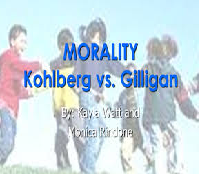Lawrence Kohlbergs vs Gilligan on Piagetian Theory Order Instructions: Lawrence Kohlberg’s research was grounded in Piagetian theory and he sought to discover how children and people develop moral reasoning.

His theory is characterized by a sequence of six stages grouped into three levels of defined morality.
Carol Gilligan taught at Harvard University with Erik Erikson. She became a research assistant for Kohlberg in the 1970s and went on to write a dissertation on moral development that criticized Kohlberg for using only privileged, white males in his research. She developed the theory of the “morality of care” as opposed to Kohlberg’s male-oriented “morality of justice.”
Write a 3-paragraph response after reading the theories Kohlberg and Gilligan offer.
• Discuss your personal view on moral development and how you potentially contribute to someone’s moral development as a teacher, family member, mentor, etc.
• Share 1 or 2 examples of how your view specifically relates to (supports or contradicts) Kohlberg and Gilligan’s theories. Be sure to consider how the individuality of each student impacts your thinking about this topic.
Lawrence Kohlbergs vs Gilligan on Piagetian Theory Sample Answer
KOHLBERG VS GILLIGAN
The Lawrence Kohlberg’s theory of the morality of justice suggests that the process of attainment of moral maturity among children takes a longer period which goes against the suggestion of Piaget’s work (Dubas, 2014). He suggested that children and people develop moral reasoning through three levels of defined morality which involve, the nonconventional level which is featured by logic based on certain principles, the conventional level which includes thinking by the necessity of norms and finally preconvention level which is featured by personal perspectives (Dubas, 2014).
The theory apparently does not value the traditional nature of education activities that suggests that certain virtues or vices form the foundation to moral behaviors. It also depicts that moral behaviors of students can be effectively approached through focusing on the stages of moral development. Carol Gilligan’s theory of morality of care suggests that the morality of attention can significantly serve in place of the morality of justice as depicted by Kohlberg (Dubas, 2014). Gilligan’s work emphasizes that care is a valuable element of moral reasoning among students. The approach puts more concern and efforts to enhance empathy and more care in students in the various institutes of learning.
Moral developments are viewed as a significant aspect of the life of every individual, for example, teaching a student to differentiate between right from wrong and the needs of having good morals (Dubas, 2014). As a teacher, I contribute to the moral development of learners through setting a good example or being a role model and provision of counseling to students on the significance of having good morals. My personal view on moral development is that students with good morals exhibit prosocial behavior as well as character traits for example being honest, fairness and having respect which supports Gillian theory.
In a nutshell, Kohlberg’s and Gillian theories of moral development differs in one way or another. However, each, and every approach tries to pinpoint various intrigues on moral developments among learners.
Lawrence Kohlbergs vs Gilligan on Piagetian Theory Reference
Dubas, K. M., Dubas, S. M., & Mehta, R. (2014). THEORIES OF JUSTICE AND MORAL BEHAVIOR. Journal Of Legal, Ethical & Regulatory Issues, 17(2), 17-35.




